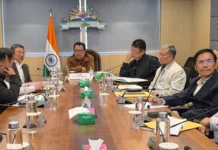[ Kakul Doley ]
Arunachal Pradesh, the ‘Land of Dawn-lit Mountains’, has long whispered tales of ancient wisdom and its cultural vibrancy. The recent forward-thinking new tourism policy of the state, categorizing wellness and spiritual tourism as a part its extensive experiential tourism initiative is set to become a beacon for travellers seeking transformative self discovery and rejuvenation, moving far beyond the ordinary vacation.
This strategic move dovetails with the flourishing wellness market in India, acknowledging the paradigm shift in global travel preferences towards pursuit of holistic wellbeing and spiritual rejuvenation. Given the genesis of Ayurveda, yoga, and multitudes of spiritual traditions in India, complemented by its affordability and authenticity in ancient healing practices, it serves as the principal locus for tourism centred on wellness and spiritual wellbeing. Valued at nearly $19.43 billion in 2024, the wellness tourism industry of India is witnessing a significant growth, projected to soar to a staggering $29.88 billion by 2031, boasting a CAGR of 6.45% (Times of India, 2025).
This growth aligns with, though differs in scale, from the global wellness tourism, which is anticipated to grow from $895.09 billion in 2024 to $978.14 billion by 2025 at a 9.3% CAGR. This growth trajectory highlights the increasingly prevalent global shift among travellers. Prioritizing preventative healthcare measures, holistic wellbeing and preference for meaningful experiences within travel is driving the wellness tourism sector.
Similarly, spiritual and religious tourism in India has also surged with a market value of $10.8 billion in 2024, which is expected to reach $28.9 billion by 2030 with an impressive compound annual growth rate of 18.2%. This positive growth trajectory provides a clear indication of the significantly and progressively large market segment expressing demand for destinations that are capable of providing authentic spiritual and wellness propositions.
The rich ethno-cultural wealth, ecological purity, spiritual legacy (ancient monasteries, sacred sites) and indigenous healing traditions of Arunachal are perfectly positioned to capture a considerable share of this expanding wellness and spiritual market. The new tourism policy’s inclusion of ‘wellness’ and ‘spiritual circuits’ within its experiential tourism framework is a masterstroke and a testament to the state’s progressive vision towards diversification. It moves beyond mere destination visit of travellers to invite active partaking through eco-wellness retreats, AYUSH-based naturopathy centres and immersive spiritual circuits. Imagine practicing yoga amidst the mist-shrouded Himalayas, meditating in the serene ambience of the Tawang monastery – the world’s second largest monastery and a revered centre of Mahayana sect of Buddhism – engaging in traditional healing therapies, or embarking to a Hindu pilgrimage site like Parshuram Kund. Arunachal holds immense potential that can be harnessed through targeted initiatives. While Tawang, famed for its Buddhist heritage and spirituality for its popular sites like Urgelling monastery – the birthplace of the 6th Dalai Lama – and the Gorsam chorten epitomizes the region’s spiritual tourism appeal, there are also similar countless lesser-known spiritual destinations and deep dive immersive experiences that also merit attention. The Donyi-Polo religion, followed by Taniclans likes Nyishis, Adis, Galos, Tagins and Apatanis, along with the Rangfra – an indigenous faith popularly followed by the Tangsa and Tutsa tribes – offers unique opportunities for understanding indigenous animistic worldviews, cementing the foundation for experiential and sustainable tourism. Beyond cultural immersion, these communities also present promising prospects for traditional healing practices using local medicinal herbs, ethno-botanical research and development of eco-wellness tourism which can be a game-changer.
Meanwhile, Zen Resort in Shergaon, West Kameng district, has already set a benchmark by harmoniously blending indigenous Sherdukpen architecture, organic food and wellness practices like yoga, meditation and digital detoxification. Given the deep-rooted connection with nature and ecological wisdom of the indigenous communities, coupled with diverse flora and fauna alongside its tranquil environment, Arunachal provides a perfect setting for naturopathy centre’s and wellness retreats.
Though there has been a significant surge in domestic tourists by over 1 million in 2022 and a massive 300% surge (4,496) in foreign travellers in 2023, Arunachal is yet to capitalize the full potential of wellness and spiritual tourism. To capitalize on the expanding spiritual and wellness market, translating the state’s revised tourism policy 2025-30 into action is paramount. The policy’s emphasis on prioritizing infrastructure development, skill development of local communities, and encouraging investment through PPP models, is vital to sustaining this trajectory of growth. A special facilitation cell for investors and identification of land banks, especially for tourism-related projects, would further fast-track tourism-led economic growth.
In conclusion, the state’s strategic hinge toward experiential tourism – wellness and spiritual sector – is a timely and visionary move. By synergizing its verdant ecological serenity with living cultural and spiritual heritage, Arunachal is moving beyond the conventional tourism playbook; it is pioneering a regenerative tourism model centered on sustainability, cultural continuity, and self-discovery of visitors – a pathway to holistic wellbeing and a testament to the India’s growing prominence as a global wellness and spiritual hub. (The contributor is a PhD research scholar at RGU, Rono Hills)



